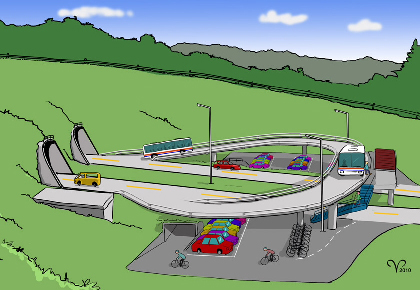Other than motorway, what $2.3 billion buys
Updated 10 September 2010

Stop the Motorway #3: Loyal supporters of public transport typically find buses are relegated to any road other than the motorway. Meantime, there is nothing to prevent park and ride being pushed through to Pūhoi. cartoon Majorlook Productions
China has 3529 kilometres in use and another 6696 under construction. High-speed rail in Japan, however, with its similarly challenging terrain is probably a better guide for Aotearoa.
But even at the relatively high Japanese rates, the cost of laying track between Pūhoi and Wellsford would half that for the proposed $2.3 billion motorway.
In fact, it’s hard to spend more on transport infrastructure without stumping up for maglev track. A Japanese Railway Maglev, on track costing merely twice as much as motorway, could whisk folk from Makaurau to Whangārei in 25 minutes.
Flying at ground level by means of magnetic levitation is the logical alternative to aviation. Not only is kerosene not good for the atmosphere, it has to be hoisted aloft along with the aircraft’s payload. Electric trains, in contrast, collect their fuel as they go.
While a case for might be made for maglev between Aotearoa’s metropolis and its capital, the far saner solution would be to phase out Wellington as the latter.
Also, levitation comes at a cost. A high-speed railway between Marsden Point and the metropolis would also want to carry heavy shipping containers, and freight maglev implementations are conspicuously absent.
The Mahurangi Club comment that led to tonight’s talk on thorium power, was the crucial point that transport electrification is not possible without more generation capacity, preferably close on hand—older New Zealanders can readily lapse into thinking of electricity as hydro and infinite. $2.3 billion would possibly buy 660 megawatts of generation capacity, in the form of small modular nuclear reactors. Being modular, and capable of being transported by rail, would seem to make the technology tailor-made for electrifying transport, without incurring the transmission losses inherent in large, centralised power generation.
Some suggest that thorium generation will be so cheap that $2.3 billion would buy several one-gigawatt plants.
Although small modular nuclear power plants are likely to be on the market much sooner than thorium, that factor may be academic. Aotearoa is less likely to trade its staunchly anti-nuclear stance for third or even fourth generation uranium powered nuclear. If it is to boldly embrace nuclear, it is more likely to do so as a standard bearer for a technology that doesn’t have a nuclear arms heritage.
Meantime, much can be done to increase energy efficiency. The cost of upgrading Northland’s existing rail is trivial. In 2004, $50 million of government’s $200 million upgrade budget was estimated to be sufficient for
tunnel enlargements, bridge strengthening and other works to remove current speed restrictions and also cater for larger freight wagons.
Presumably it was spent elsewhere.
A further $120 million will connect the main trunk line to Marsden Point. With the land designated and property purchases well underway, a halfway competent transport minister could have fast-tracked this energy efficient solution, and funded safety upgrades to State Highway One.
Specifically, the $2.3 billion likely cost of the proposed commuter motorway spent on rail with trail, the Marsden Point Line and State Highway One safety upgrades would transform the economy of Northland.
As for the Pūhoi economy, it is perfectly served by the status quo. If the motorway is extended northward, Pūhoi will see far fewer visitors—motorway access or no motorway access.
The big economic picture is that countries that quickly transition to become low energy economies will be competitive. Australian economist Dr Ben McNeil in The Clean Industrial Revolution warns that
climate change and our over reliance on fossil fuels will put Australia’s economic prosperity, not just the environment, at great risk.
To paraphrase SolonAs published: Aristotle—a bum steer by Philip C Bolger!, call no country lucky until you know the manner of its climate change.
